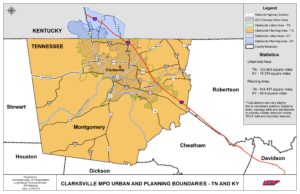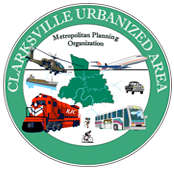What is an MPO?
A Metropolitan Planning Organization (MPO) is entrusted by law with the responsibility for developing transportation plans and programs for urbanized areas with populations of 50,000 people or more.
MPO By Laws
How is an MPO formed?
An MPO is designated by agreement between the Governor and local governments representing 75% of the affected metropolitan population. This agreement outlines the membership of its policy-making body, standing committees, and geographic area served by the MPO.

Who belongs to an MPO?
Membership of the MPO’s policy body is outlined in the federal regulations. Membership must include representation by local elected officials, officials of agencies that administer or operate major modes or systems of transportation, and appropriate state officials.
Executive Board and TCC Members
How is the planning area determined?
At a minimum, the MPO’s planning area must cover the urbanized and contiguous geographic areas likely to become urbanized within the next 20 years. Areas designated as non-attainment (not meeting the EPA standard for certain pollutants) under the Clean Air Act, must be included in the MPO boundary, unless there is an agreement between the MPO and the Governor. The MPO boundary should foster effective planning, enhance connections between transportation modes, improve access to the region’s transportation systems, and promote effective use of transportation funds.
How does the MPO relate to the regional and local Planning Commissions?
The MPO coordinates transportation planning activities in support of the Regional Planning Commission or local planning authorities. The MPO is a conduit for coordinating transportation plans and programs needed to support state and local comprehensive plans. The MPO provides a forum for improving communication and understanding between local governments and state agencies.
What does the MPO do?
The Fixing America’s Surface Transportation (FAST) Act outlines the metropolitan planning process which the MPO must follow. This process includes the development of a Metropolitan Transportation Plan (MTP), a Transportation Improvement Program (TIP), and an annual Unified Planning Work Program (UPWP). All of these products must be developed with the consideration of ten planning factors in FAST. These factors are:
- Support the economic vitality of the metropolitan area, especially by enabling global competitiveness, productivity, and efficiency;
- Increase the safety of the transportation system for motorized and non-motorized users;
- Increase the security of the transportation system for motorized and non-motorized users;
- Increase accessibility and mobility of people and freight;
- Protect and enhance the environment, promote energy conservation, improve the quality of life, and promote consistency between transportation improvements and state and local planned growth and economic development patterns;
- Enhance the integration and connectivity of the transportation system, across and between modes, for people and freight;
- Promote efficient system management and operation;
- Emphasize the preservation of the existing transportation system;
- Improve the resiliency and reliability of the transportation system and reduce or mitigate stormwater impacts of surface transportation; and
- Enhance travel and tourism.
The Unified Planning Work Program outlines the planning priorities facing the region and describes all transportation and transportation-related air quality planning activities anticipated in the region within the next one or two-year period. It details who will perform the work, the schedule for completion, and the products to be produced. The UPWP contains all of the region’s transportation planning projects regardless of funding sources or agencies conducting them.
At least every three years, the MPO must develop a Transportation Improvement Program which lists the projects for which federal transportation funds will be spent during at least a three-year period. The MPO must demonstrate that the projects in the TIP will not worsen the region’s air quality and that funding is reasonably available to complete them. The MPO must have a definitive process for prioritizing and selecting projects to be included in the TIP. The prioritization process must be directly related to the current goals and future needs outlined in the MPO’s Metropolitan Transportation Plan.
